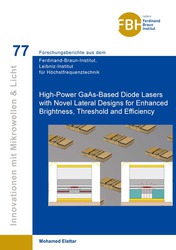| Areas | |
|---|---|
| Serie de libros (96) |
1378
|
| Nachhaltigkeit |
3
|
| Gesundheitswesen |
1
|
| Letra |
2364
|
| Ciencias Naturales |
5406
|
| Ciencias Ingeniería |
1793
|
| Ingeniería | 292 |
| Ingeniería mecánica y de proceso | 862 |
| Ingeniería eléctrica | 686 |
| Mineria y metalurgía | 30 |
| Arquitectura e ingeniería civil | 75 |
| General |
98
|
|
Leitlinien Unfallchirurgie
5. Auflage bestellen |
|
Erweiterte Suche
High-Power GaAs-Based Diode Lasers with Novel Lateral Designs for Enhanced Brightness, Threshold and Efficiency (Volumen 77) (Tienda española)
Mohamed Elattar (Autor)Previo
Lectura de prueba, PDF (330 KB)
Indice, PDF (32 KB)
GaAs-based 9xx-nm broad-area diode lasers (BALs) offer the highest optical power (Popt) among diode lasers and the highest conversion efficiency (ηE) among all light sources. Therefore, they are widely used in material processing applications (e.g. metal cutting), which additionally require high beam quality (i.e. low beam parameter product BPP), typically limited in BALs along the lateral axis (BPPlat). Enhancing BAL performance is dependent on identifying the thermal and non-thermal limiting mechanisms, and implementing design changes to minimize their effects. In this work, two novel approaches based on lateral structuring are developed, aiming to overcome different limiting mechanisms acting along the lateral axis. First, the enhanced self-aligned lateral structure (eSAS) is based on integrating structured current-blocking layers outside the BAL stripe to centrally confine current and charge carriers, thereby suppressing lateral current spreading and lateral carrier accumulation. Two eSAS variants are optimized using simulation tools, then realized in multiple wafer processes, followed by characterization of mounted BALs. eSAS BALs exhibit state-of-the-art Popt and lateral brightness (Popt/BPPlat), with clear benefits over standard gain-guided BALs in terms of threshold, BPPlat and peak ηE. The second approach is chip-internal thermal path engineering, based on structured epitaxial layers replaced outside the stripe by heat-blocking materials to centrally confine heat flow. This flattens the lateral temperature profile (i.e. reduces thermal lensing) around the active zone, which is associated with enhanced brightness. Finite-element thermal simulations are used to estimate the benefits of this approach, thereby motivating its practical realization in future studies.
| ISBN-13 (Impresion) | 9783689520342 |
| ISBN-13 (E-Book) | 9783689520472 |
| Formato | A5 |
| Idioma | Inglés |
| Numero de paginas | 124 |
| Laminacion de la cubierta | mate |
| Edicion | 1. |
| Serie | Innovationen mit Mikrowellen und Licht. Forschungsberichte aus dem Ferdinand-Braun-Institut, Leibniz-Institut für Höchstfrequenztechnik |
| Volumen | 77 |
| Lugar de publicacion | Göttingen |
| Lugar de la disertacion | TU Berlin |
| Fecha de publicacion | 26.07.2024 |
| Clasificacion simple | Tesis doctoral |
| Area |
Ciencias Ingeniería
Ingeniería eléctrica |
| Palabras claves | high-power diode laser, lateral design, lateral structuring, self-aligned, eSAS, current confinement, current spreading, lateral carrier accumulation, thermal path, heat flow, thermal lensing, waveguide, semiconductor, wafer, technology, waveguiding, metallization, magnitude, superlattice, optoenergy, etch, conductivity, optical power, GaAs-based, conversion efficiency, ηE, light source, metal cutting, beam quality, high beam quality, lateral axis, BAL performance, non-thermal limiting mechanisms, non-thermal limiting mechanism, thermal limiting mechanism, thermal limiting mechanisms, enhanced self-aligned lateral structure , eSAS, current-blocking layer, current-blocking layers, lateral current spreading, lateral carrier accumulation, Hochleistungsdiodenlaser, laterale Strukturierung, selbstausrichtend, eSAS, Stromeinschluss, Stromspreizung, laterale Ladungsträgerakkumulation, thermischer Pfad, Wärmefluss, thermische Linsenbildung, laterales Design,Wellenleiter, Halbleiter, Wafer, Technologie, Wellenleitung, Metallisierung, Größe, Übergitter, Optoenergie, Ätzen, Leitfähigkeit, optische Leistung, GaAs-basiert, Umwandlungseffizienz, ηE, Lichtquelle, Metallschneiden, Strahlqualität, hohe Strahlqualität, laterale Achse, BAL-Leistung, nicht-thermische Begrenzungsmechanismen, nicht-thermische Begrenzungsmechanismen, thermische Begrenzungsmechanismen, thermische Begrenzungsmechanismen, verbesserte selbstausrichtende laterale Struktur , eSAS, stromsperrende Schicht, stromsperrende Schichten, laterale Stromausbreitung, laterale Ladungsträgerakkumulation |








